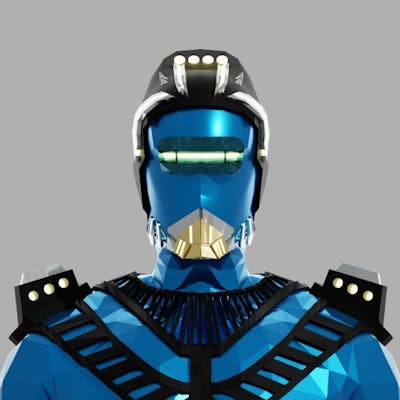How to use effective marketing to turn your NFT collection into blue-chip
The genesis 💀
BAYC, Moonbirds, Azuki, Doodles etc., NFT collections are piling up, but only 1% of NFTs ever made sell for more than $1,500. A whopping 75% sell for $15 or less, and most don’t even sell at all. Your NFT collection is more likely to fail than become an instant hit. This guide is for you if you’re ready to hack growth for your latest or existing collection. I discussed how you could craft an ace marketing strategy for a new or existing NFT collection that you can use to drive your project to achieve a blue-chip status. This piece covers both the planning and execution phases, and it is tailored to the needs of both a marketer and a founder. If you love NFTs, then let’s journey together.
Some weeks back, I was discussing with the founder of an NFT collection, and he asked me the most straightforward question ever “what NFT collections are you familiar with?” Guess what, I couldn’t answer. It was still early morning for me, and my coffee was yet to kick in. Perhaps another reason for getting gobsmacked by that simple question may well be due to the explosive pace with which NFTs are growing, not minding the bloodbath currently happening in the market today. So if you’re a founder or part of an NFT collection team, it’s best if you start to realise it’s not going to get easier. You’ll need more than regular marketing to stand out from the crowd. If you’re looking for a perfect NFT marketing playbook to become an instant hit, sorry to disappoint you, but nothing like that exists. In this piece, I aim to show you how to grow your collection using simple but time-tested strategies rooted in essential core marketing theories.
Having been in this industry pre-Cryptokitties days, I try to make sense of all that is happening in the space today, documenting my thoughts to help anyone who also needs to make sense of events. See my piece on sifting through an evolving NFT industry beyond the hype culture of digital artset, where I discussed mainly NFT utilities. I relate with NFT founders and collectors daily, who are pretty versed in NFT marketing and promotion. Understandably some don’t see the need to optimise your NFT collection growth marketing for key metrics such as
Increasing the number of wallets holding your collection.
Increasing volume across secondary trading platforms.
Stabilising and possibly increasing the NFT floor price.
Their argument, of course, is based on the premise that the days of the mad rush are over and now is reality time, especially as the down cycle kicks into full effect. I disagree. What comes to mind when you think of any popular collections out there? Floor price and how hyped the community is. I understand a collector might want to just buy and hold because of the deep connection with such NFT. Yes, the culture may be strong. Still, most people trading blue chips do it because of their insane volume, impacting the floor price and the rush to want to own it — wallet holders.
Now let’s get to it!
A solid blueprint is the first step 📝
“If you fail to plan, you are planning to fail!” ~ Benjamin Franklin
So if I put the same question to you to mention any of the top collections out there, I bet you’ll say goblintown and its derivatives because of their recent surge, even displacing the hegemony of BAYC and its sister collections on Opensea? Not so fast! CryptoPunk should be on your list. But here is the thing, while the OG NFT project has attained blue-chip status today, I argue that the creators never thought it would grow the way it turned out. Larva Labs (now acquired by Yuga Labs), the developers behind the Punk project, have had to make constant changes to the project’s roadmap and utility as they grew. My point here is that while your collection could be the next Cryptopunk, it probably needs to do more in terms of marketing to achieve blue-chip status. Why? Cutthroat competition is what we see in the NFT landscape today. Adopting a laissez-faire approach in your marketing could seriously stifle your project's chances of attaining blue chip status.
Adequate pre-planning, even before planning, is not a necessity but a must. In the case of CryptoPunks the project team didn't just sit back, twiddling their thumbs and enjoying their first-mover advantage after launching. They were quick to react and adapt to the rapidly changing landscape as newer collections stampeded the market. Marketing moves such as partnering with major brands like the United Talent Agency (UTA), and launching and distributing Meebits, a secondary collection for their community, were pivotal in solidifying CryptoPunk's leadership position in the industry so much that it looked attractive for Yuga Labs guys to splash millions for the merger. Hence, adopting a forward-thinking marketing blueprint as a new collection is essential because it makes your plan adaptable to current realities and not just a rigid strategy. This is the philosophy behind growth hacking; constant experimentation and doubling down on what works. Like Seth Comstock would say,
“Marketing’s job is never done. It’s about perpetual motion. We must continue to innovate every day.”
Since innovation is a pivotal aspect of marketing, having a blueprint to guide you through the different stages of your NFT growth is essential. As a new project looking to dive into the competitive NFT landscape, analysing the NFT market through a marketing framework such as the Ansoff Matrix can help you determine the best strategic ways to accomplish your growth objectives.
The Ansoff Matrix theory captures the fundamentals of growth hacking and project expansion into four components—market penetration, market development, product development and diversification. Existing collections looking to increase their adoption could employ market penetration strategies such as reducing floor price to attract new buyers, increasing promotion and distribution or acquiring a competitor. On the other hand, new collections can employ a market penetration strategy by offering lower floor prices, especially now the industry is wobbling through a bear cycle. Per product development strategy, this gives you a sense of what type of NFT to bring to market; a collection with a strong meme culture/push? Or just using meme culture as a marketing tool, rather than pinning your entire strategy for your mint on memes? Others from aesthetics, uniqueness or utility should be covered when adopting the Ansoff product development approach. The bottom line is that you must understand the current market landscape and then adjust your product design and launch strategy based on current realities while still maintaining a long-term playbook.

The Ansoff Matrix is also a useful concept for understanding various market risks specific to your project.
Now, let’s plan!
Pre-launch stage ⏳
Before you start planning out your marketing strategy, one important thing every project team needs to have in mind is that when it comes to NFTs, culture is of utmost importance.
Think about it, memes largely drive the value of NFTs, and memes are a means by which cultural values are propagated in today’s society. NFTs represent digital culture and, therefore, a bridge between culture and money. Understanding this is very critical in channelling value towards your collection. The following pointers can build a strong and pervasive culture around your NFT project.
Understand what makes your NFT valuable: Culture is a community's shared experiences and beliefs. It is what defines people's perception of your project. It is the narrative that attracts people to your work. You need to define what makes your collection valuable. One way to do this is by highlighting its flex value. NFT collectibles are similar to designer wear and limited edition luxurious cars. Think about your Ferrari, Gucci bag or Chris Louboutin shoes; these are what NFT collections with different levels of rarity serve in our modern digital age because of their finite supply and brand uniqueness. Products that are limited in quantity give owners a sense of importance and power. Even amongst a collection, there are varying rarities. Hence, a BAYC NFT with Gold fur can sell above another BAYC with laser eyes. People want to be able to flaunt their most prized collections or holdings, knowing fully well it is not mass-produced. Hence, when planning your NFT blueprint, focus on the value, uniqueness, and rarity your NFT can offer to your holders.
Get unique: Uniqueness + aesthetics = eccentricity, which means not easy to beat; hence people start creating derivatives around your collection. Moonbirds, BAYC, Cool Cats, Azukis, Punks, and Doodles are all unique and not copycats of another collection. Become the standard from which other derivatives are created. See Moonbiirds, an AI-based collection like AllNight Birds, are Moonbirds-inspired collections, giving the latter more importance and popularity. Same thing is happening with Goblintown. Whether hand-drawn or generative arts, what is the lore behind a collection? Is it one that has been told before or fresh off the cuffs? A chip off the old block is a one-way direction to irrelevance as people can easily dismiss your collection as a copypasta of another, which kills your authenticity. Look into avatars or creatures that appeal to your target collectors and draw out cult-like followership when choosing the visual appearance of your collection. There's a reason the top collections are created around dogs, cats, apes or animes.

Cozomo de’ Medici, the NFT influencer account controlled by veteran rapper, Snoop Dogg, in one of his tweets, "The 5 things I look for in a pfp collection", hammered on this. The TLDR here is that it's not enough to generate 10,000 variations of some jumbled up avatar character. A collection needs to tell a story, a story that resonates with your audience and community. Therefore to drive a given narrative, a lot of work and effort needs to go into creating something worth holding.
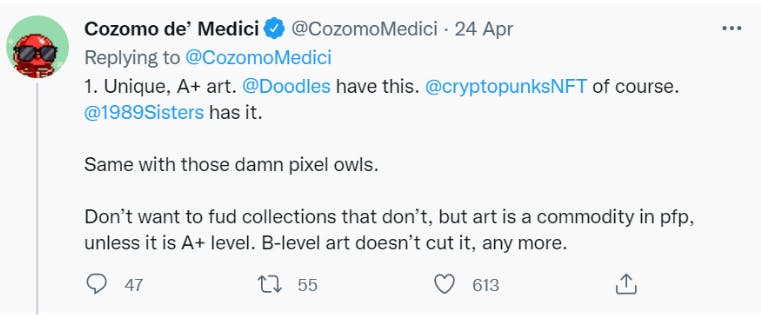
User-focused planning stage 🏋🏽
Know your audience: You’ve created the ideal collection and now looking to attract an army of believers around it. Well, the question is, who should you enlist in that army. The logical step here is to arm yourself with an in-depth knowledge of your target audience. Create a customer avatar or buyer persona to help you focus on the right persons. Why is this important? Well, if your NFT is dog-themed, the demographics of your target audience will be largely different from, say, an anime-themed NFT like the Azuki collection. A report by Morning Consult reveals that millennials are 3 times as likely as Gen Z to buy NFTs, with about 42% being collectors and 32% of esports fans interested in NFTs. For geopositioning, Statista reports that China is most interested in NFTs, followed by Singapore, Venezuela, and Hong Kong (so don't think only the West drive the narrative around NFTs). There's a reason the Azuki collection took off like wildfire among Asian holders such as Korea, Japan and Singapore. This is because the average Asian loves anime and anime games. Once you're able to unlock your ideal user avatar, it gives you a clearer picture of which mega or micro-influencer you should start courting for a potential partnership to help promote your collection. An influencer whose major audience are web3 folksies may not be the best person to enlist in your influencer marketing if you need crazy degens using jump on your bandwagon. Here, I must mention that you must not be tempted to think you don’t need influencer marketing to drive the message home to your audience. Perhaps you think that because you don’t have the social capital as a collection founder to bring the likes of Paris Hilton or Elijah Wood on board, you don’t need influencer marketing. There is another option, leverage micro-influencers. My experience is that on LinkedIn and Twitter, some of these not so big n influential accounts are those dishing out the best nuggets. Seek them out and build an infantry ready to go to war with you.
Unique messaging for your circle: How do you communicate your project? What’s the code? What tingles people's ears and makes them stop to see what you’re saying in a crowded NFT industry? Don’t make the mistake of trying to change people with your messaging. Meet them exactly where they are, and you are on your way to building a cult-like following. Entities did not create Degen, Aping, REKT and whatnot. Still, people in this circle have institutionalised them as part of the crypto culture, which births the lingo of everyday communication in this space. The culture and bond that your language births will result in a cult-like following. An example here is the bitcoin laser eyes craze of 2020, where top celebrities began using the laser eyes as their pfp on social media, Satoshi didn't ask them to do so. Another example is WAGMI (we are all gonna make it), a word coined by famous late bodybuilder Zyzz. During the DeFi summer of 2020 and 2021, WAGMI and NGMI (never gonna make it) were used to encourage or discourage investors from hopping on a moonshot or a walking dead project. The idea here is to incentivize creativity, smartly operating from the shadows and encouraging such creativity with incentives. Your community is most likely to craft amazing languaging codes knowing fully well, they'll be incentivized if it catches on. Let them feel they have the power, this is what community in web3 is all about.
Scarcity is key: ‘The first lesson of economics is scarcity: there is never enough of anything to fully satisfy all those who want it. The first lesson of politics is to disregard the first lesson of economics.’ Thomas Sowell While it is true that scarcity drives value, it is essential to note that investors have to consider an asset value for its scarcity logic to kick in. Take Bitcoin, with only 21 million tokens, and there are currently between 18 and 19 million bitcoin in circulation. Imagine what will happen when the last Bitcoin is mined? Unlike fungible tokens like Ethereum and Bitcoin, NFTs display a high level of scarcity, creating a market where users place value on an asset based on how rare it is. Therefore, having too much supply in your collection can dilute its market value. Therefore, ensure that the supply of your NFT collection is limited relative to your followership. I consider an NFT collection founding team’s decision of 10,000 total supply for minting in a 3,000 membered community an unwise move. Why would I want to buy something that not everyone is interested in? How many contrarians are really there to always bet against popular market sentiments? Whether bear or bull, FOMO will always be there, but the effect is only determined by how much you’re able to create a scarcity mindset among those willing and able to buy your collection. Your mint total supply should always be lesser than your community numbers. Taake, the case of the only two Koenigsegg CCXR Trevita, was ever made in 2009, and Floyd Mayweather acquired one of them. Or the only 39 1962 Ferrari 250 GTO ever made, the cars were able to rake in over $30 million as the sale of one car, with scarcity driving up its demand and value. You can utilise this strategy with your collection. Thanks to innovations like fractionalization platforms like Quantix as many people that are interested can still get a piece of your collection once it goes premium. Supply is never an issue, demand is!
Communicate utilities: If you don’t want your collection to be easily dismissed as a fugazi, clearly sharing the utility to holders is crucial. Explain your product in clear, simple sentences; utility is about benefits, which must be written or said with users in mind. Don’t be tired of communicating this across all platforms. If you can’t hack the utility aspect of your collection, perhaps you should delay the launch. And if you really can’t hack it, then maybe you can consider platforms like Tropee, a plug n play NFT utility platform, helpful in adding utilities to your collection. The beauty of this is that you could even do it progressively. Let’s say your project is a collection based on Native American artefacts; you can plug a utility that gives buyers access to clothes or pieces of jewellery made by Native American artists.
Enlist notable backers: Having the backing of heavy duties in the industry gives a project significance and credibility. As long as you have done your homework well, you’ll be comfortable pitching to influential funds. Ensure to reach out and secure the support of recognised collectors in the space. Imagine having figures like Elijah Woods and Paris Hilton associated with your collection; it boosts the credibility of your project.
Get doxxed: Self-doxxing is underrated. I know some think it doesn’t matter, not really for NFTs where legendary rug pulls happen every time. There’s a reason why some teams remain anon. Dig deeper, and you just might find some skeletons. I understand some teams do this because they want to be able to focus and not get dragged every time because their identities are out there, but this has been abused. Especially for the long term growth of your community, consider self-doxxing. Azukis learned this hard when the space discovered that Zagabound had staged 3 rug pulls (CryptoPhunks, Tendies, and CryptoZunks). Disclosure matters, especially when you have a tethered past as a collection founder. I bet it’s only a matter of time before you get called out, do it yourself, and early on. Nothing drives a project downhill faster than its community losing trust in its founders. And in a fast-paced industry like NFT, you need your community to trust you as you churn out projects and utility and veer for partnerships.
Website: This is first-timers land when they want to learn more about what your project. It's your collection's home address, make sure it properly designed. By design, I do not only mean aesthetics. While that is important, design also means how something functions. Communicate project perks and benefits in a few written, simple sentences to guide users to your call to action effectively. And if you're a minimalist, make people curious. I like the way goblintown presents its website.
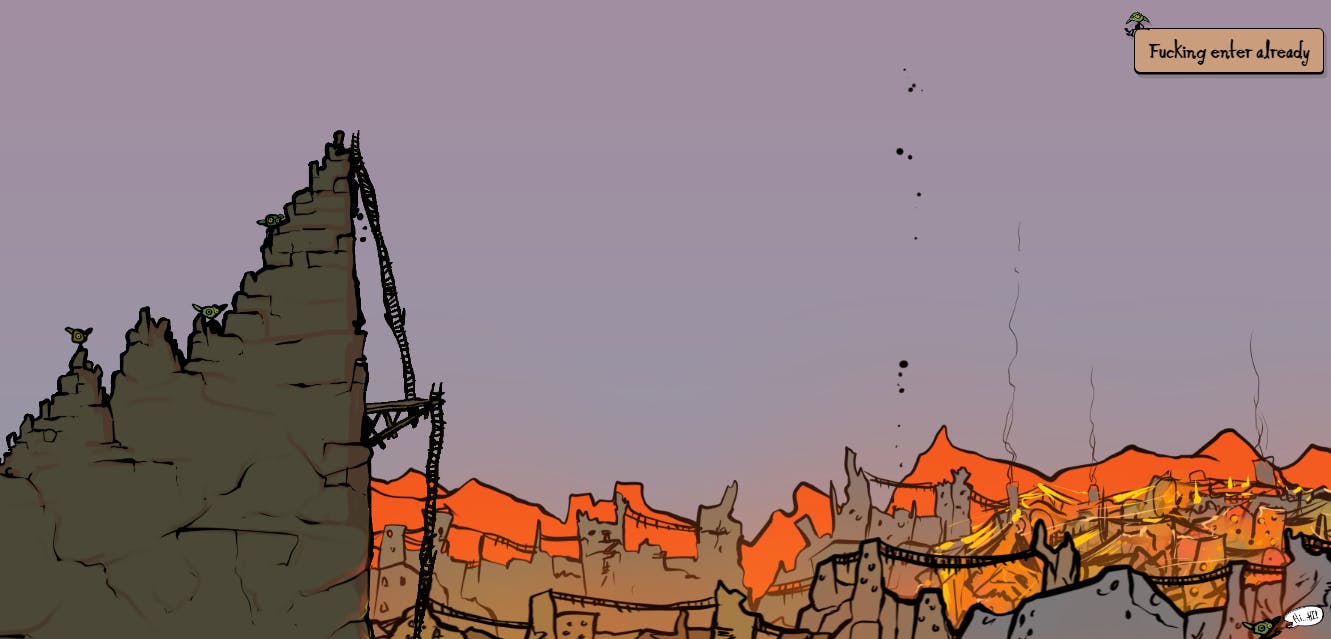 goblintown's landing page
goblintown's landing page
During Launch 🏌🏽
Appeal to influencer interest: You must realise that even your typical NFT influencer still cares about how much gains they can extract from your collection. By gains, I am not only boxing that to mean quickly flipping for the moolah alone. From getting WL for early sales to securing a spot for future NFT drops and other project-specific benefits, influencers can be courted to help promote your collection only if you plan this from the beginning. Take BAYC for instance, Jimmyeth bought over 400 pieces of Apes and shilled the collection to Pransky, who would take the collection to another dimension introducing it to celebs such as Gary V., Steve Aoki, NBA players and even auctioned some to Sotheby. Why did this strategy work for BAYC? Think about a circle of influential people united in purpose because they are part of a community. This is always a net positive for influencers and they know it. Hence, any collection that can offer this to them is always worth considering.
Stage a coordinated attack on social media: Many people think only Twitter and Reddit are important for marketing NFTs. A project collection should have Instagram, Facebook, Twitter, Pinterest, TikTok etc., handles. Yes, have an account on other social media platforms, even if you don’t intend to use all of them at once. Facebook for running inexpensive ads and reaching non-natives; Instagram for celebrities; Twitter for engaging thought leaders in the space and communicating to the largest pool of crypto faithful; TikTok is a popular social platform among GenZs. So, do not box yourself where social media is concerned.
Requests reviews: Think of it as getting a 5-star rating on the App store; third party reviews for your collections can definitely help improve your brand profile. You can enlist the service of podcasters, crypto/NFT bloggers, and vloggers to independently review your collection. Don’t hesitate to reach out to critical art analysts to give an objective assessment of your collection. But you must be careful as some of them might give critical reviews, which still represents a learning experience for you regardless.
Partnerships and collaboration 🤝
Cross-collection collaboration for new experiences: I know this may be hard to pull off, but collaboration with blue chips or other promising collections can give you the needed boost towards attaining the high-value status. Strike a deal with a giant, Jane Applegate advised in her book '201 Great Ideas for Your Small Business. A big partner can provide the reach to propel an entrepreneur's growth". Reach out and collaborate with other projects to create engaging exercises that provide your audience with the opportunity to acquire collections from other communities. You can also create a hybrid collection by collaborating with artists. For instance, NFT artist Ali Sabet created 3 hybrid NFTs with the BAYC theme, all of which have sold out with an average price of $1500 each. Also, Cross-collaborate with other aspects of the NFT industry to create unique experiences. For instance, players in Galaxy Fight Club can use the characters in Cyberkongz, Iluvium, Animetas, Wicked Craniums, and more to fight in the game, creating a wholesome experience for the community.
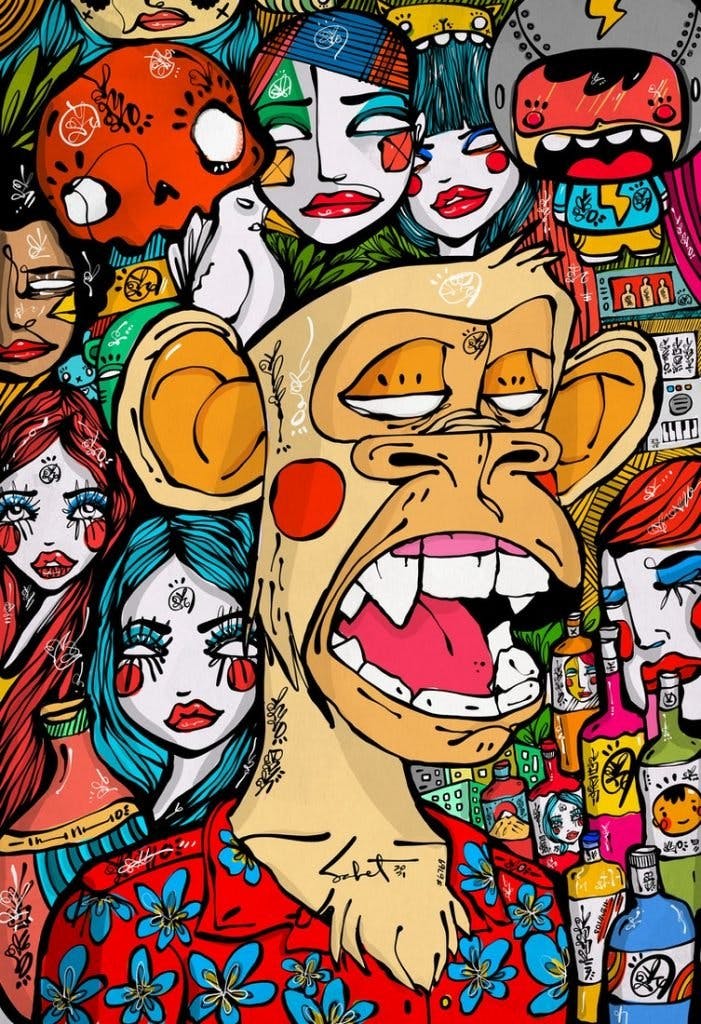 An image of Sabet’s hybrid NFT, a collaboration with Trust Me Vodka’s organic and gluten-free vodka
An image of Sabet’s hybrid NFT, a collaboration with Trust Me Vodka’s organic and gluten-free vodka
IRL collaboration: You think of In Real Life (IRL) utility immediately when building your collection. NFTs do not have utility inherently built into them. You have to attach a real-life value to your collection. When thinking of partnership, you also need to create IRL utility or value for your community. You can partner with non-NFT companies/projects just like the Bored Wine Company, an initiative that allows BAYC members to invest in real-world fine wine bottles. Another example is CryptoBarristas serving caffeinated NFTs. For every NFT sale, the holder gets access to exclusive coffees and discounts on Cryptobarista merchandise. Also, holders acquire voting rites to determine the project's future and control the funds in the project’s ‘Baristas Bank’.
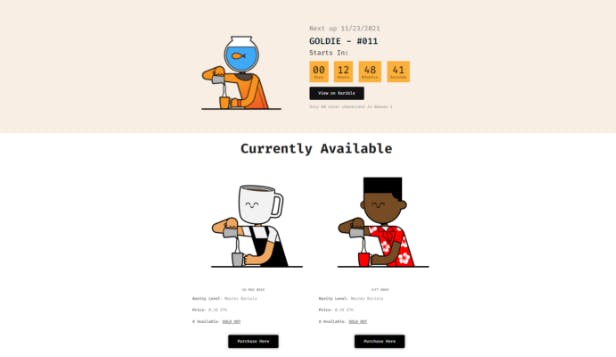 Cryptobarrista NFT collection
Cryptobarrista NFT collection
After planning comes the execution stage 🔓
Without proper execution, your planning can only yield suboptimal results. Take practical and actionable steps to execute your planned strategies. Do away with the "build it, and they will come" mentality. You could develop the most unique and rare NFT collection, ticking all the boxes of a great project, and no one would care. You must aggressively push your work in front of your stakeholders (holders, investors and the broader crypto community), continuously get them excited to be part of your community and create an emotional connection with them around your project. As I explained above, here are some actionable steps to effectively execute all your documented plans.
Communicate roadmap: Breathe life into your roadmap: Organise AMAs and communicate every time you hit a specific milestone. Roadmaps are not only for a still website or whitepaper; they live through a collection founder’s actions. Make it exciting and inspiring with all the difficulties that come with it; as you are building NFT collections like Moonbirds, BAYC is showing us how it’s done. Except you’re rewarding your community for a treasure hunt in searching and finding a clear roadmap, stamp your roadmap on your website, whitepaper, etc. This makes you accountable and puts you on your toes to constantly work and smash each milestone on that road map. It's a form of transparency. And every time the project needs to make changes according to new market realities, carry the community along if possible and let the community decide which way a project needs to go through polling or input during AMA. It becomes better even when there is a DAO to reach a consensus on it. BAYC and Apecoin holders did this recently by voting down the AIP-29 proposal submitted by Snopp Dogg's team for the ApeDrops marketplace expansion. The proposal was voted down on the grounds that it would cost the community a whopping $2 million, which most community members deemed too extravagant.
FAQs: Listen in on the questions newbies, and even OGs are asking on your Discord server, AMA's and even on Tweets. Take note of these questions, document them and translate them into FAQs on your website. Communicate everything there is to know in detail about your collection. Avoid unnecessary jargon and make your FAQ visible and easy to understand. I like to use Intercom for FAQs and customer support; it's an easy-to-use platform and gives you the added benefit of SEO visibility.
Flex access to notable backers: You successfully enlisted the support of prominent backers; the next step is flexing them. If you have big names associated with your project, you need to let people know about it. Massively leverage their association to build and expand your community. Don't just stop at having them invest and using your collection as their pfp, go for more. Have them canvas openly as long as they are comfortable doing that. For example, you could organise AMAs and interviews with these investors to supercharge engagement.
Give back to the community: How about sharing a portion of your NFT sales profit such as royalties, staking, back to the community? We say web3 is read, write, OWN. The “own” stands for community. Prove it! Without a community of believers, an NFT collection is just another worthless picture album looking to stage a quick money grab.
Whitelist spots: Whitelist giveaways are a very effective way of getting attention and generating hype around your project. Participants of your giveaway campaign perform simple yet effective tasks like making a post or sharing your posts and creating user-generated content (UGC) around the NFT. This mainly applies to art-based NFTs where their value is uniquely personal. Each person interprets the art according to how they feel. Giving followers whitelist spots helps create excitement around a project and also helps to build more followers. You can choose to give away directly or collaborate with Twitter influencers and let them give away the spots.
Gamify engagement: Gamify engagement in your discord server to make people contribute meaningfully. Offer whitelist (WL) spots for your presale before minting. Tap into the uniqueness and enterprising nature of your community. Let’s say you’re music NFT, rollout contests where community members can create posts about a concert they attended and tag your project to it. You can reward those with the highest engagement and meaning to your project with ultra-rare pieces in your collection. Some NFT collections have a DAO that enables community members to serve different roles within the community bringing in their skills. PartyDAO and its NFT community with over 1,707 members have hacked this strategy, and recently, MeeBits and Rarible also have a DAO around their communities. With a strategy such as this in place, you get a community that can carry out tasks from content writing to community promotion and governance tasks.
Influencer collaboration & promo: Collaborate with or get influencers to talk about your NFT. A couple of tweets or threads from the right influencer can be compelling. Help them create contents that highlight the perks of your project. You must get influencers whose lifestyle or professional work resonates with the theme of your NFT collection. For instance, an influencer whose activities revolve around anime may not suit your animal-themed NFT collection. You should also invest in influencer promotions. Subtle tactics such as getting recognised influencers in the NFT space to change their profile picture to your NFT collection are very effective. Also, make art pieces for big influencers in the space to try and get them to retweet, giving your NFT collection some recognition and credibility. You could also try out non-crypto influencers with large followings and have them communicate to their followers the utilities of your collection. This is a way to onboard new and enthusiastic people into your community.
Adopt a tiered membership community: Instead of shutting out people who do not own your collection by creating an ‘all-exclusive’ community, you can build a tiered membership creating an entry for all into the NFT space while still providing exclusivity. For instance, Vee and friends, Gary Vee’s NFT collection has an exclusive community for its holders and also allows holders from top-tiered communities such as Superducks, BAYC or Doodles into its community. A strategy such as this helps promote your NFT collection amongst blue-chip communities.
Don't spam: I know it is always tempting to capitalise on the current trend in the NFT market to impact floor price, number of wallets holding your NFTs and possibly increase your revenue. A prevalent one in the NFT space is the "tag a friend" whitelist giveaway. I see a lot of newly launched collections doing this. This is a grave mistake! Imagine getting unsolicited tags on Twitter over a collection you know nothing about. I don't know about any other person, but it comes off annoying. Don't incentivise your community to do this as a growth hack. It may end up backfiring. Get creative with your whitelist giveaways and make your target audience feel it is worth their time. Find a way to influence genuine participation in your campaigns without having to tag a friend or perform regular pushy spam. An activity such as “write what you think about us in one word” while tagging the brand will still put the content in the face of people. Imagine 500 people tweeting about your project at the same time?
Get Google busy 🔎
Stamp your identity across Google. What do you think most people do when they get wind of a new promising NFT collection? Yes. They Google it! They want to find out more about the project. You've piqued their interest; now it's time to get them hooked. What do you want Google's front page to roll out when someone searches the name of your collection? You have to be very intentional here. Invest heavily in SEO. Optimise for the best content around your collection that helps carve out a good amount of mindshare. Without winning the mindshare game, you don't get market share. Prioritise quality over quantity. More blogs, social media posts, emails and webinars won't cut it.
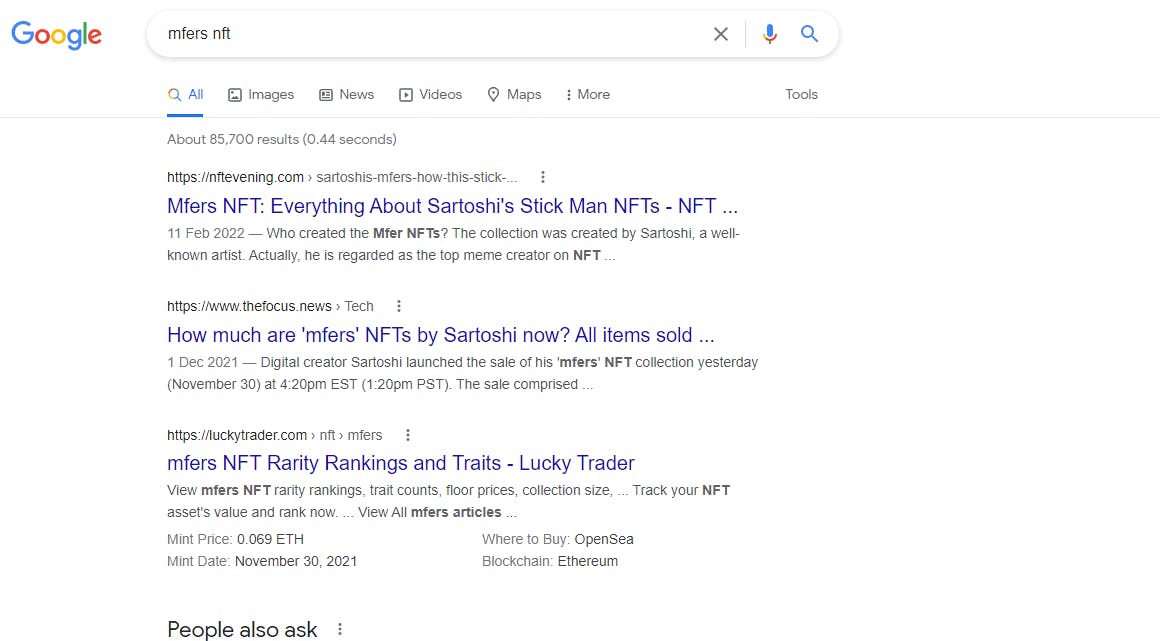
Instead, leverage data. Start by looking at what successful collections have done right. Then take it a step further by researching content that competes with yours. Use Google to search for vs and listicle articles. Then use a Competitive Content Landscape Template to map them out. The list you draw up can help you know which project to partner with and those to compete against. It can also help you understand how to niche down and focus on a particular audience instead of creating content for the sake of just making them. More tactics to boost your Google rankings and, by extension, your brand visibility include;
Long-tail keyword-focused blog posts - less competitive and easier to rank. These keywords are also effective in reaching targeted audiences and improving conversion rates.
Infographics - leverage visual content marketing. Infographics are sharable and linkable and are the most effective link-building method. Remember, a picture is worth a thousand words.
Long-form research articles - helps to establish authority in your domain. Collection founders should employ this strategy, publishing on Medium, hackernoon, Mirror.xyz to help with top of mind awareness. You should also consider guest-posting on platforms like NFTevening, Cointelegraph, Decrypt and other tier A crypto and NFT media platforms. All these adds up incremental to Google busy.
Build a rock-solid PR plan - Invest in telling your story. In the vast ocean of NFT collections offering almost the same incentives to holders, you cannot risk not adopting a differentiation strategy. Make sure you're on top of your PR game.
Solidify your social media presence 📱
Create a connection with your community through AMA - AMAs are important and not just time wasters to you as the founding team of a collection and not to the community. These chats can be held on Telegram or Twitter Spaces, recorded and repurposed to keep your content pipeline flowing. Explore podcasts as this also helps to build your search profile across the internet. But just don't use podcasts to replace AMAs as it only target one speaker, or a few speakers at a time while social audio can allow multiple speakers at a time from your community members to ask questions and make suggestions.
Boost your visibility with videos (Educational, NFT reveal and hype videos) - Instagram and TikTok have been able to hack their users' behavioural patterns and engineered their algorithms to favour more video content. You have to be intentional and ensure that your video content is top-notch. You can create hype videos for Twitter, Tiktok and Instagram reels, and educational videos for Youtube. Also, Podcasts, interviews and AMAs can be converted to Youtube videos. With video marketing, you can generate buzz for your NFT through videos.
Leverage ads and social media marketing - You can generate leads by creating different landing pages targeting specific social media and search platforms and running PPC ad campaigns. These campaigns will be designed to target specific audiences that frequent these platforms. Run targeted ads on YouTube, LinkedIn, Facebook and Twitter or Google as long as the algo allows it.
Email marketing remains an OG - Email marketing is still super effective in engaging with your audience, and you can leverage it for your tiered community by providing the latest happenings and important tidbits for your subscribers. Set up a drip email campaign meeting each member of your community where they are. The beauty of email marketing is that you can use it to send personalized messages which can help create a strong between between your collection and the community. So milk it!
Case studies of marketing tricks employed by top-tier NFT collections
Uniqueness: There are amazing blue chips out there of course but I like to use these: Cryptopunks, CyberKongz, Cool Cats, DeadFellaz, Goblintown, Moonbirds and the famous Bored Apes as solid references per uniqueness threshold. It takes a lot of creativity and deep thoughts to create something unique before every other starts to draw inspiration, copy and even create a ton of derivatives from it.

A clear purpose: Successful collections have clear and specific missions, whether one or multiple, they must be clear and able to galvanise the community towards a common purpose. A project's mission can be centred around art, an artistic message, or supporting an artist. Some can be about raising awareness or funding social good. Onchain Monkey, a social impact NFT project by Metagood makes its mission clear —empowering communities to be catalysts for positive collective action. Projects could also draw significance from history or culture.

Most NFT projects fit into more than one of these categories. And nothing wrong with evolving per the collection's purpose, just don't shift the goal post every time. A collection can start with a focus on art, but as it grows, can capitalise on its deep pocket, social relevance, IP, and strong community support to do more things such as creating a game, an animated series, staking, additional airdrops of new NFTs, etc.; the Bored Ape Yacht Club is a prime example of this.
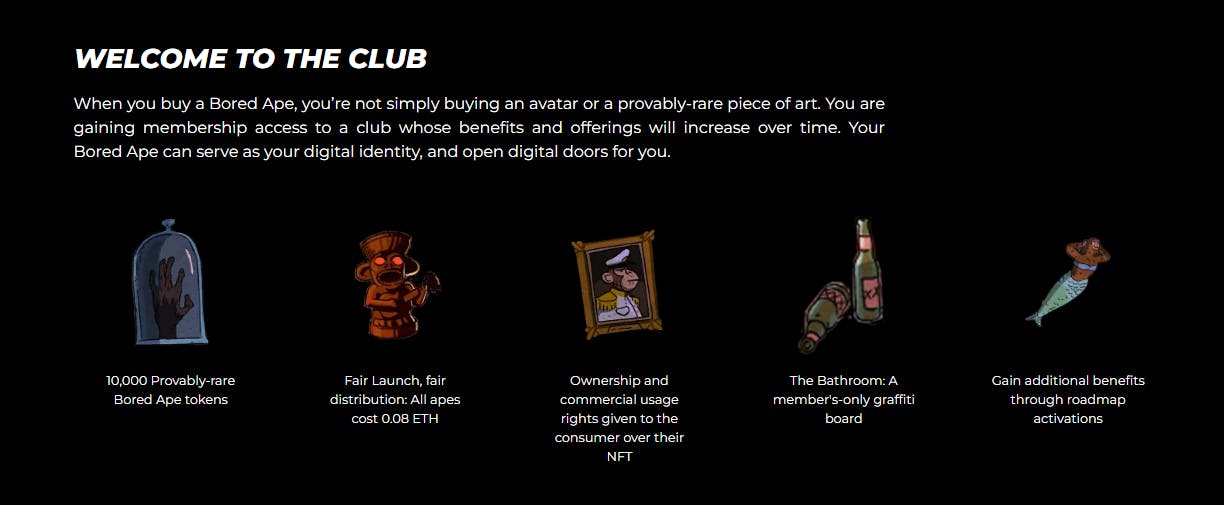
Strong and dedicated team: An anon team leading an NFT collection is almost always a bad sign. The space is awash with cases of rug pulls and scams most times staged by anon founders. Having active social media accounts and some background on team members can go a long way. Better still, an endorsement from recognised and trusted figures in the NFT space such as Zeneca, Beanie or Pransksy. Platforms like Discord and Twitter are helpful tools to gauge the determination and commitment of team members.
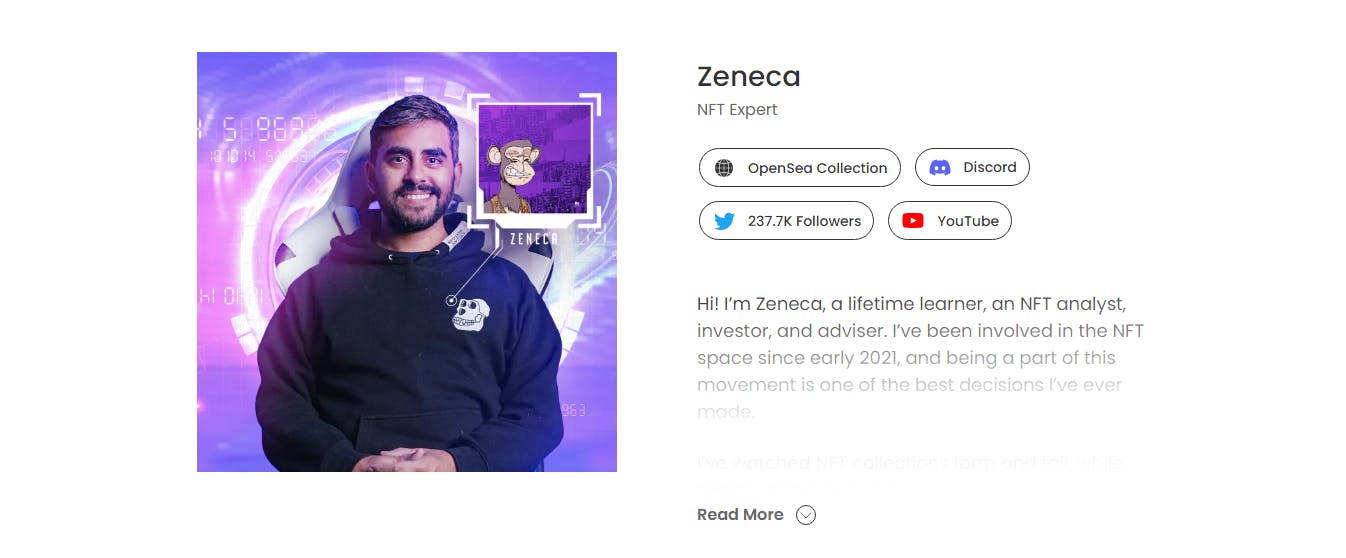

Die-hard community: You can have your social media handles buzzing as a collection but the many are just interested in flipping for quick gains. NFTs are by nature illiquid making it very easy for as little as two trades to significantly swing floor price. Therefore, your collection needs to amass as many community members as possible comprising shrimps, big fishes and whales of course to help cushion against sudden price swings. The more the die-hard members in your crowd, the merrier!
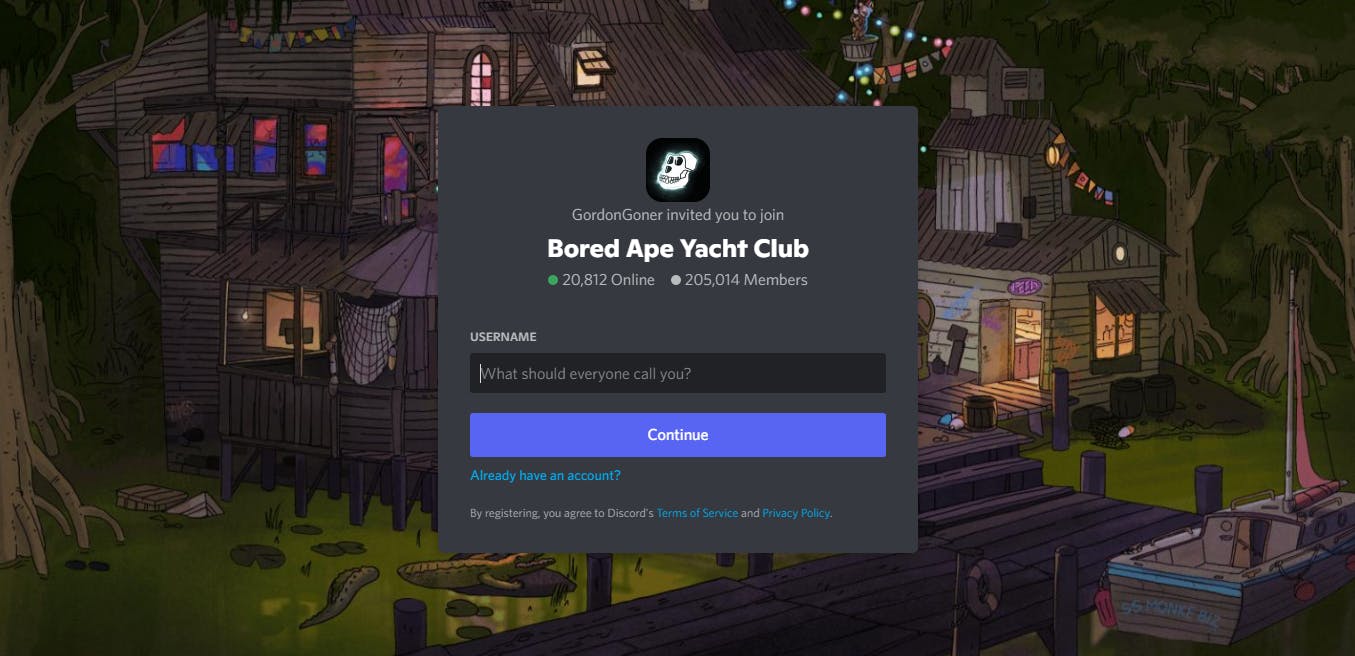
Final thoughts
So you’ve read up to this point, excited and thinking, “I’ve got the perfect NFT marketing playbook” for my collection; let’s go.” I think not! I made it clear from the start that there’s no such thing as a perfect marketing playbook that guarantees success every time. See a collection like mfers or goblintown? Decent floor price but with no roadmap, no utility, all IP rights donated to the artwork to the public domain under a Creative Commons 0 (CC0) license, riding on the waves of strong meme culture, yet are by all standards, blue chip. All of these point to the fact that you cannot take away the place of luck for some highly successful collections you see today. Yet, you still cannot and shouldn’t leave your collection’s success to chance. You have to be intentional, dynamic and able to adapt swiftly.
NFTs or not, if you’re launching a new collection and hope to profit from it, then you must treat it as a business: value for value and not leaving it to luck. You offer value in terms of specific utilities to your target market, and the market rewards you in return.
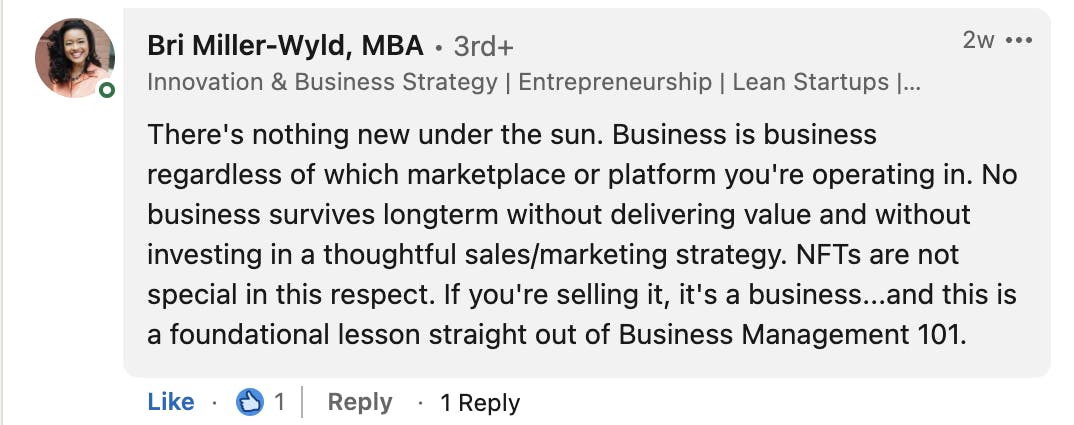 Bri Miller-Wyld reacting to my post on LinkedIn where I announced I’d be writing a piece on NFT marketing
Bri Miller-Wyld reacting to my post on LinkedIn where I announced I’d be writing a piece on NFT marketing
If your vision is to treat your collection as a business, then I expect you to create a checklist from this guide and tick them off one after the other. And if you’re a fantastic collection and think you need help in areas of marketing and growth, feel free to reach out to me on LinkedIn or Twitter. May the odds be ever in your favour!
